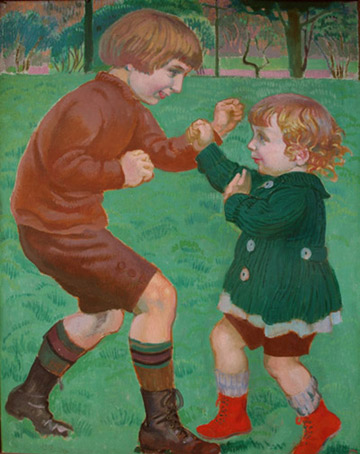
Maurice Denis La Boxe, 1918, oil on cardboard, 85 x 70 cm, private collection
© Catalogue raisonné Maurice Denis / ADAGP, Paris 2009 |
|
MUSÉE NATIONAL DE L'ORANGERIE
Jardin des Tuileries
75001 Paris
INFORMATION:
Tel. 01 44 77 80 07
Bookings / information: www.rmn.fr
HOURS OF ADMISSION:
Every day except Tuesdays,
from 9 am to 6 pm.
PRICE OF ADMISSION :
Full price: € 4.50 Concessions € 3.50
CURATOR:
Emmanuel Bréon, chief curator,
director of the Musée de l’Orangerie
PRESS CONTACTS:
Florence Le Moing
florence.lemoing@rmn.fr
Elodie Vincent
elodie.vincent@rmn.fr
Exhibition catalogue:
22x28 cm, 296 pages, 140 color illustrations,
RMN, paper bound € 39
Exhibition organised by the Musée de l'Orangerie and the Réunion des Musées Nationaux

|
Art historians seldom focus on an artist’s family , children and close friends, the people who supported, encouraged, or simply loved him. Whether they were willing or reluctant models, often sketched unaware by a friendly ogre, the exhibition introduces us to these “model children” through nearly one hundred paintings.
They are the sons or daughters of Claude Monet, Maurice Denis, Pablo Picasso, Françoise Gilot, Georges Sabbagh, Chana Orloff, the nieces and nephews of André Derain and Pierre Bonnard, even the “surrogate children” of Édouard Vuillard who became very fond of his patrons’ offspring. Some of these child models have left written or oral testimonies; others still talk of their experiences today. The children of the Edwardian era, dressed for the occasion and perfectly posed, little Nabis, Fauves or Cubists turned into masterpieces for museums, or late 20thcentury kids in jeans and sneakers but no freer to move tell us in their own way about the sittings that left them with mixed memories.
The exhibition and the catalogue give the youngsters a mouthpiece. The “dear little devils” tell us in their own words that they were often more strongly attracted by their games, their street friends or the solitary reveries so important at their age than by what the artists saw as a mark of tenderness. So, “stuck” there “to be nice”, Jean-Marie Le Breton thought only of running through the countryside, Jean-Paul Belmondo itched to go roller skating through the family apartment with his brother Alain, and Pierre Arditi longed to get down from the red chair where his father had stationed him.
Although some artists such as Claude Monet seldom used their immediate family, others — Eugène Carrière, Pierre-Auguste Renoir, Mary Cassatt, Maurice Denis, Georges Sabbagh or Pablo Picasso — almost made it a specialty. The often numerous children in these “small tribes” were frequently very tenderly portrayed; but they were also used as mere subjects for studies. Maurice Denis, the “Nabi who made beautiful icons”, used all his family members as models for his paintings, religious or profane. Picasso fathered many children, and he and Françoise Gilot both sketched their children of their union, Claude and Paloma. Without children of their own, artists such as André Derain, Pierre Bonnard or Édouard Vuillard simply invented a family circle.
Painting a child is no easy matter. Many artists’ memoirs reveal the strategies they used to keep them still. The “dear little devils” were posed on their own with the props that their artist-parents had deliberately chosen for them: a Pierrot or clown costume, a wooden horse, a croquet mallet, a hoop, a rag doll, a sailing boat, or shown absorbed by their favourite occupations. These toys or costumes (sometimes real relics) are dotted throughout the exhibition.
|









